Yan Wang
Fudan university
OpenOneRec Technical Report
Dec 31, 2025Abstract:While the OneRec series has successfully unified the fragmented recommendation pipeline into an end-to-end generative framework, a significant gap remains between recommendation systems and general intelligence. Constrained by isolated data, they operate as domain specialists-proficient in pattern matching but lacking world knowledge, reasoning capabilities, and instruction following. This limitation is further compounded by the lack of a holistic benchmark to evaluate such integrated capabilities. To address this, our contributions are: 1) RecIF Bench & Open Data: We propose RecIF-Bench, a holistic benchmark covering 8 diverse tasks that thoroughly evaluate capabilities from fundamental prediction to complex reasoning. Concurrently, we release a massive training dataset comprising 96 million interactions from 160,000 users to facilitate reproducible research. 2) Framework & Scaling: To ensure full reproducibility, we open-source our comprehensive training pipeline, encompassing data processing, co-pretraining, and post-training. Leveraging this framework, we demonstrate that recommendation capabilities can scale predictably while mitigating catastrophic forgetting of general knowledge. 3) OneRec-Foundation: We release OneRec Foundation (1.7B and 8B), a family of models establishing new state-of-the-art (SOTA) results across all tasks in RecIF-Bench. Furthermore, when transferred to the Amazon benchmark, our models surpass the strongest baselines with an average 26.8% improvement in Recall@10 across 10 diverse datasets (Figure 1). This work marks a step towards building truly intelligent recommender systems. Nonetheless, realizing this vision presents significant technical and theoretical challenges, highlighting the need for broader research engagement in this promising direction.
Counterfactual VLA: Self-Reflective Vision-Language-Action Model with Adaptive Reasoning
Dec 30, 2025Abstract:Recent reasoning-augmented Vision-Language-Action (VLA) models have improved the interpretability of end-to-end autonomous driving by generating intermediate reasoning traces. Yet these models primarily describe what they perceive and intend to do, rarely questioning whether their planned actions are safe or appropriate. This work introduces Counterfactual VLA (CF-VLA), a self-reflective VLA framework that enables the model to reason about and revise its planned actions before execution. CF-VLA first generates time-segmented meta-actions that summarize driving intent, and then performs counterfactual reasoning conditioned on both the meta-actions and the visual context. This step simulates potential outcomes, identifies unsafe behaviors, and outputs corrected meta-actions that guide the final trajectory generation. To efficiently obtain such self-reflective capabilities, we propose a rollout-filter-label pipeline that mines high-value scenes from a base (non-counterfactual) VLA's rollouts and labels counterfactual reasoning traces for subsequent training rounds. Experiments on large-scale driving datasets show that CF-VLA improves trajectory accuracy by up to 17.6%, enhances safety metrics by 20.5%, and exhibits adaptive thinking: it only enables counterfactual reasoning in challenging scenarios. By transforming reasoning traces from one-shot descriptions to causal self-correction signals, CF-VLA takes a step toward self-reflective autonomous driving agents that learn to think before they act.
Beyond Artifacts: Real-Centric Envelope Modeling for Reliable AI-Generated Image Detection
Dec 24, 2025Abstract:The rapid progress of generative models has intensified the need for reliable and robust detection under real-world conditions. However, existing detectors often overfit to generator-specific artifacts and remain highly sensitive to real-world degradations. As generative architectures evolve and images undergo multi-round cross-platform sharing and post-processing (chain degradations), these artifact cues become obsolete and harder to detect. To address this, we propose Real-centric Envelope Modeling (REM), a new paradigm that shifts detection from learning generator artifacts to modeling the robust distribution of real images. REM introduces feature-level perturbations in self-reconstruction to generate near-real samples, and employs an envelope estimator with cross-domain consistency to learn a boundary enclosing the real image manifold. We further build RealChain, a comprehensive benchmark covering both open-source and commercial generators with simulated real-world degradation. Across eight benchmark evaluations, REM achieves an average improvement of 7.5% over state-of-the-art methods, and notably maintains exceptional generalization on the severely degraded RealChain benchmark, establishing a solid foundation for synthetic image detection under real-world conditions. The code and the RealChain benchmark will be made publicly available upon acceptance of the paper.
Benchmarking and Enhancing VLM for Compressed Image Understanding
Dec 24, 2025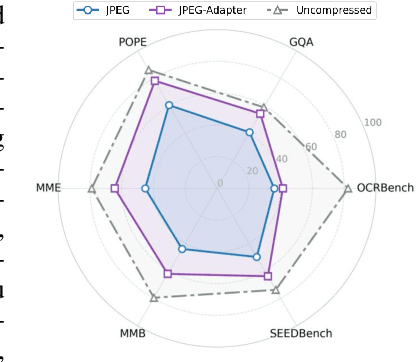

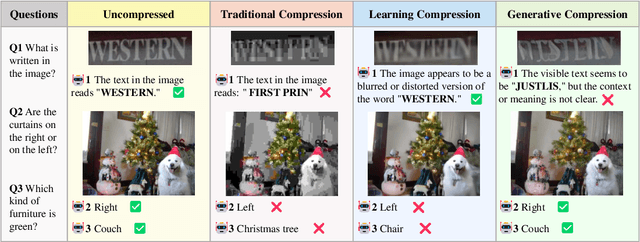
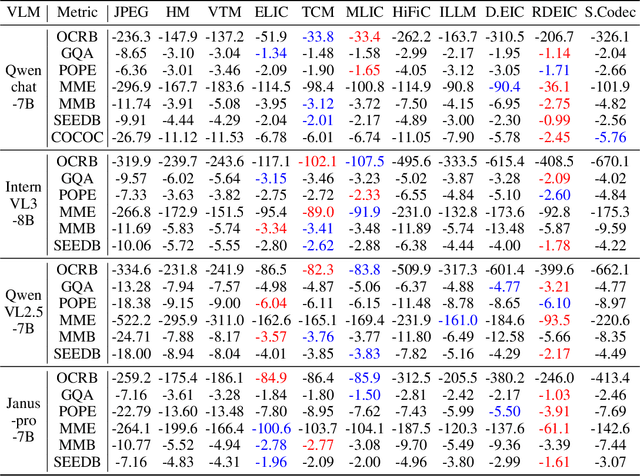
Abstract:With the rapid development of Vision-Language Models (VLMs) and the growing demand for their applications, efficient compression of the image inputs has become increasingly important. Existing VLMs predominantly digest and understand high-bitrate compressed images, while their ability to interpret low-bitrate compressed images has yet to be explored by far. In this paper, we introduce the first comprehensive benchmark to evaluate the ability of VLM against compressed images, varying existing widely used image codecs and diverse set of tasks, encompassing over one million compressed images in our benchmark. Next, we analyse the source of performance gap, by categorising the gap from a) the information loss during compression and b) generalisation failure of VLM. We visualize these gaps with concrete examples and identify that for compressed images, only the generalization gap can be mitigated. Finally, we propose a universal VLM adaptor to enhance model performance on images compressed by existing codecs. Consequently, we demonstrate that a single adaptor can improve VLM performance across images with varying codecs and bitrates by 10%-30%. We believe that our benchmark and enhancement method provide valuable insights and contribute toward bridging the gap between VLMs and compressed images.
GaussianImage++: Boosted Image Representation and Compression with 2D Gaussian Splatting
Dec 22, 2025Abstract:Implicit neural representations (INRs) have achieved remarkable success in image representation and compression, but they require substantial training time and memory. Meanwhile, recent 2D Gaussian Splatting (GS) methods (\textit{e.g.}, GaussianImage) offer promising alternatives through efficient primitive-based rendering. However, these methods require excessive Gaussian primitives to maintain high visual fidelity. To exploit the potential of GS-based approaches, we present GaussianImage++, which utilizes limited Gaussian primitives to achieve impressive representation and compression performance. Firstly, we introduce a distortion-driven densification mechanism. It progressively allocates Gaussian primitives according to signal intensity. Secondly, we employ context-aware Gaussian filters for each primitive, which assist in the densification to optimize Gaussian primitives based on varying image content. Thirdly, we integrate attribute-separated learnable scalar quantizers and quantization-aware training, enabling efficient compression of primitive attributes. Experimental results demonstrate the effectiveness of our method. In particular, GaussianImage++ outperforms GaussianImage and INRs-based COIN in representation and compression performance while maintaining real-time decoding and low memory usage.
AgentIAD: Tool-Augmented Single-Agent for Industrial Anomaly Detection
Dec 15, 2025Abstract:Industrial anomaly detection (IAD) is difficult due to the scarcity of normal reference samples and the subtle, localized nature of many defects. Single-pass vision-language models (VLMs) often overlook small abnormalities and lack explicit mechanisms to compare against canonical normal patterns. We propose AgentIAD, a tool-driven agentic framework that enables multi-stage visual inspection. The agent is equipped with a Perceptive Zoomer (PZ) for localized fine-grained analysis and a Comparative Retriever (CR) for querying normal exemplars when evidence is ambiguous. To teach these inspection behaviors, we construct structured perceptive and comparative trajectories from the MMAD dataset and train the model in two stages: supervised fine-tuning followed by reinforcement learning. A two-part reward design drives this process: a perception reward that supervises classification accuracy, spatial alignment, and type correctness, and a behavior reward that encourages efficient tool use. Together, these components enable the model to refine its judgment through step-wise observation, zooming, and verification. AgentIAD achieves a new state-of-the-art 97.62% classification accuracy on MMAD, surpassing prior MLLM-based approaches while producing transparent and interpretable inspection traces.
Towards Efficient and Effective Multi-Camera Encoding for End-to-End Driving
Dec 12, 2025Abstract:We present Flex, an efficient and effective scene encoder that addresses the computational bottleneck of processing high-volume multi-camera data in end-to-end autonomous driving. Flex employs a small set of learnable scene tokens to jointly encode information from all image tokens across different cameras and timesteps. By design, our approach is geometry-agnostic, learning a compact scene representation directly from data without relying on the explicit 3D inductive biases, such as Bird-Eye-View (BEV), occupancy or tri-plane representations, which are common in prior work. This holistic encoding strategy aggressively compresses the visual input for the downstream Large Language Model (LLM) based policy model. Evaluated on a large-scale proprietary dataset of 20,000 driving hours, our Flex achieves 2.2x greater inference throughput while improving driving performance by a large margin compared to state-of-the-art methods. Furthermore, we show that these compact scene tokens develop an emergent capability for scene decomposition without any explicit supervision. Our findings challenge the prevailing assumption that 3D priors are necessary, demonstrating that a data-driven, joint encoding strategy offers a more scalable, efficient and effective path for future autonomous driving systems.
Latent Chain-of-Thought World Modeling for End-to-End Driving
Dec 11, 2025Abstract:Recent Vision-Language-Action (VLA) models for autonomous driving explore inference-time reasoning as a way to improve driving performance and safety in challenging scenarios. Most prior work uses natural language to express chain-of-thought (CoT) reasoning before producing driving actions. However, text may not be the most efficient representation for reasoning. In this work, we present Latent-CoT-Drive (LCDrive): a model that expresses CoT in a latent language that captures possible outcomes of the driving actions being considered. Our approach unifies CoT reasoning and decision making by representing both in an action-aligned latent space. Instead of natural language, the model reasons by interleaving (1) action-proposal tokens, which use the same vocabulary as the model's output actions; and (2) world model tokens, which are grounded in a learned latent world model and express future outcomes of these actions. We cold start latent CoT by supervising the model's action proposals and world model tokens based on ground-truth future rollouts of the scene. We then post-train with closed-loop reinforcement learning to strengthen reasoning capabilities. On a large-scale end-to-end driving benchmark, LCDrive achieves faster inference, better trajectory quality, and larger improvements from interactive reinforcement learning compared to both non-reasoning and text-reasoning baselines.
FinCriticalED: A Visual Benchmark for Financial Fact-Level OCR Evaluation
Nov 19, 2025Abstract:We introduce FinCriticalED (Financial Critical Error Detection), a visual benchmark for evaluating OCR and vision language models on financial documents at the fact level. Financial documents contain visually dense and table heavy layouts where numerical and temporal information is tightly coupled with structure. In high stakes settings, small OCR mistakes such as sign inversion or shifted dates can lead to materially different interpretations, while traditional OCR metrics like ROUGE and edit distance capture only surface level text similarity. \ficriticaled provides 500 image-HTML pairs with expert annotated financial facts covering over seven hundred numerical and temporal facts. It introduces three key contributions. First, it establishes the first fact level evaluation benchmark for financial document understanding, shifting evaluation from lexical overlap to domain critical factual correctness. Second, all annotations are created and verified by financial experts with strict quality control over signs, magnitudes, and temporal expressions. Third, we develop an LLM-as-Judge evaluation pipeline that performs structured fact extraction and contextual verification for visually complex financial documents. We benchmark OCR systems, open source vision language models, and proprietary models on FinCriticalED. Results show that although the strongest proprietary models achieve the highest factual accuracy, substantial errors remain in visually intricate numerical and temporal contexts. Through quantitative evaluation and expert case studies, FinCriticalED provides a rigorous foundation for advancing visual factual precision in financial and other precision critical domains.
Commonality in Few: Few-Shot Multimodal Anomaly Detection via Hypergraph-Enhanced Memory
Nov 16, 2025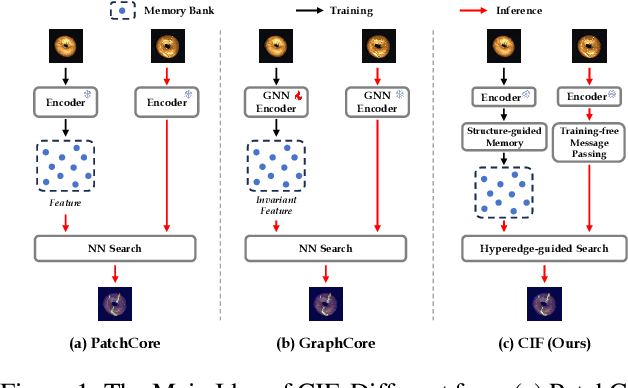
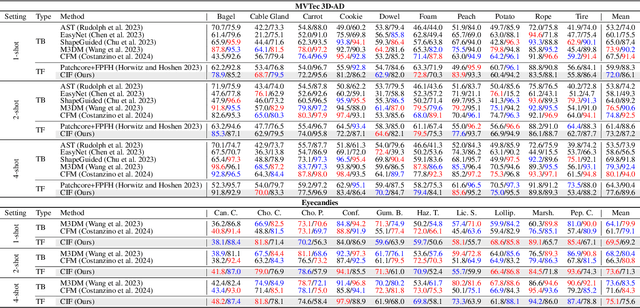
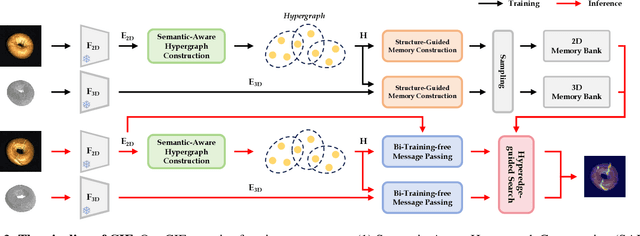

Abstract:Few-shot multimodal industrial anomaly detection is a critical yet underexplored task, offering the ability to quickly adapt to complex industrial scenarios. In few-shot settings, insufficient training samples often fail to cover the diverse patterns present in test samples. This challenge can be mitigated by extracting structural commonality from a small number of training samples. In this paper, we propose a novel few-shot unsupervised multimodal industrial anomaly detection method based on structural commonality, CIF (Commonality In Few). To extract intra-class structural information, we employ hypergraphs, which are capable of modeling higher-order correlations, to capture the structural commonality within training samples, and use a memory bank to store this intra-class structural prior. Firstly, we design a semantic-aware hypergraph construction module tailored for single-semantic industrial images, from which we extract common structures to guide the construction of the memory bank. Secondly, we use a training-free hypergraph message passing module to update the visual features of test samples, reducing the distribution gap between test features and features in the memory bank. We further propose a hyperedge-guided memory search module, which utilizes structural information to assist the memory search process and reduce the false positive rate. Experimental results on the MVTec 3D-AD dataset and the Eyecandies dataset show that our method outperforms the state-of-the-art (SOTA) methods in few-shot settings. Code is available at https://github.com/Sunny5250/CIF.
 Add to Chrome
Add to Chrome Add to Firefox
Add to Firefox Add to Edge
Add to Edge